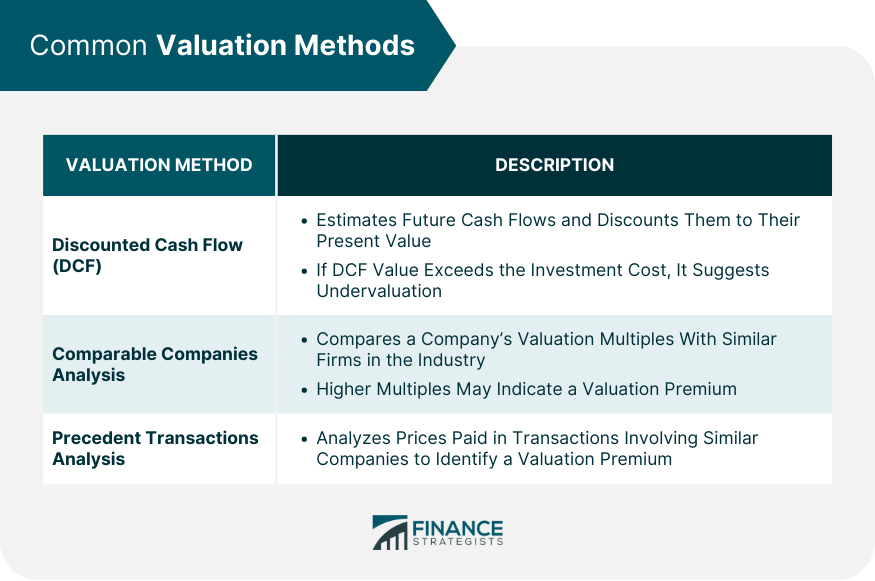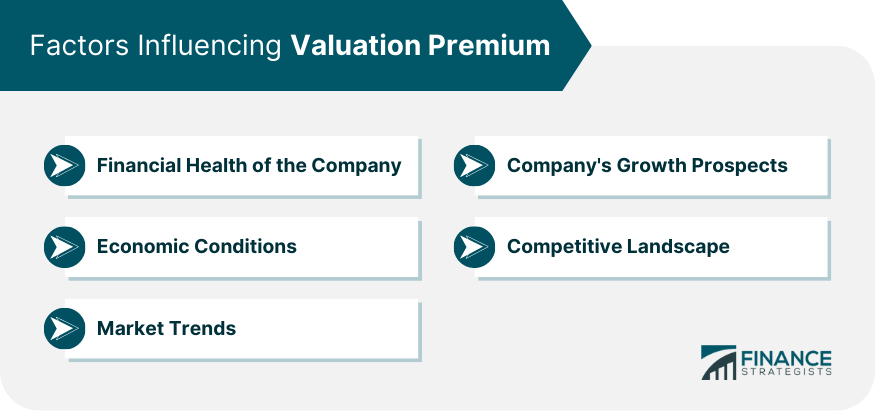Valuation premium refers to the additional amount a buyer is willing to pay over the perceived fundamental value of a business or asset. This occurs when the buyer believes the intrinsic value of the company is higher than the market price or the assessed value. Essentially, it is a measure of the extra worth investors assign to an organization due to factors such as growth potential, strategic advantage, or brand recognition. The concept of valuation premium is crucial in financial analysis as it provides an in-depth understanding of how market participants value a company. It is widely used in various contexts, such as mergers and acquisitions, private equity transactions, and company evaluations. An elevated valuation premium often signals strong investor confidence, while a low or negative valuation premium could suggest concerns about the business's future prospects. DCF is a widely used valuation method method in finance. It involves estimating the future cash flows a company will produce and then discounting them back to their present value at a rate that reflects their risk. If the DCF value is higher than the current cost of the investment, this suggests that the investment could be undervalued and hence, has a valuation premium. This method involves comparing the company's valuation multiples (such as Price/Earnings, Price/Sales, or Price/Book) with those of similar firms in its industry. If a company's multiples are higher than the industry average, it may indicate a valuation premium. This method involves examining the prices paid in transactions that involved companies similar to the ones being valued. These transactions provide a market-tested measure of what buyers are willing to pay, which can help identify a valuation premium. A company in good financial health is likely to command a higher valuation premium. Indicators of financial health include strong cash flow, low debt, high-profit margins, and a consistent track record of revenue growth. The state of the economy also affects the valuation premium. In a growing economy, companies may command a higher valuation premium because investors are willing to pay more for future growth. Conversely, in a recession, the valuation premium may shrink as investors become more risk-averse. Investors often place a valuation premium on companies that are well-positioned to capitalize on emerging market trends. For example, technology companies in sectors such as artificial intelligence, cloud computing, or renewable energy may command a high valuation premium. Companies with strong growth prospects often attract a high valuation premium. Investors are willing to pay more for these companies because they expect future earnings to be higher, which should lead to higher stock prices. The competitive landscape can impact the valuation premium. If a company has a unique product, a strong brand, or a strategic market position, it could command a higher valuation premium. Calculating valuation premiums requires understanding the company's intrinsic value and its market value. The intrinsic value is typically calculated using one of the valuation methods described earlier (DCF, Comparable Companies, or Precedent Transactions). The market value is the current share price multiplied by the number of outstanding shares. The valuation premium is the difference between these two values, expressed as a percentage of the intrinsic value. The calculation of the valuation premium involves several variables and assumptions. For example, when using the DCF method, one needs to estimate future cash flows, the growth rate, and the discount rate. Similarly, with Comparable Companies and Precedent Transactions methods, one needs to choose appropriate multiples and comparable companies or transactions. Let's consider a practical example to illustrate the calculation of valuation premium. Suppose a technology company has an intrinsic value of $100 per share (calculated using DCF), and its current market price is $120 per share. The valuation premium would be ($120-$100)/$100 = 20%. Another example might involve a healthcare company that is trading at a P/E multiple of 20x, while the average P/E for the healthcare industry is 15x. This suggests a valuation premium of (20-15)/15 = 33.3%. In the context of M&A, a valuation premium refers to the additional amount an acquirer is willing to pay over the target company's current market value. This typically occurs when the acquiring company perceives the target company's intrinsic or strategic value to be higher than its market value. Valuation premium plays a crucial role in M&A transactions. It can influence both the willingness of the acquirer to pay and the acceptance of the offer by the target's shareholders. A higher valuation premium could make the deal more attractive to the target company's shareholders, but it might also increase the financial burden on the acquirer and the risk of the deal not generating sufficient returns. The calculation of valuation premium can differ significantly between public and private companies due to the availability of information and liquidity of the shares. Public companies have transparent financials, and their shares are easily traded, which helps establish a market value for the firm. Conversely, private companies often have limited financial disclosure, and their shares are not freely tradable, making their valuation a more complex process. In both markets, the valuation premium is influenced by factors such as the financial health of the company, the economic conditions, the competitive landscape, and the company's growth prospects. However, the weight given to each factor may differ. For example, the premium for private companies may be more influenced by the unique attributes of the firm and the specifics of the transaction. In public markets, a prime example is the valuation premium attached to tech giants like Amazon and Google, where investors are willing to pay high multiples due to these companies' market dominance, innovation capabilities, and robust growth prospects. In private markets, valuation premiums often appear in venture capital or private equity transactions. For instance, startups with disruptive technologies but no profits (or even revenues) might command substantial valuation premiums due to their high growth potential. Valuation premiums, like any financial concept, can be misunderstood or misused. Some investors might mistake a high valuation premium as an absolute indicator of a good investment, ignoring the company's fundamentals or the economic conditions. On the other hand, companies might be tempted to artificially inflate their valuation premium through aggressive accounting or unrealistic projections. One limitation of the valuation premium is that it's largely based on subjective estimates and assumptions, which can lead to significant variations in the calculated premium. Furthermore, a high valuation premium does not necessarily translate to actual returns, especially if the premium is driven by market exuberance rather than solid fundamentals. Alternatives to valuation premium as a measure of value might include absolute valuation methods, like DCF, or relative valuation methods, like P/E or P/B multiples. Additionally, some investors prefer to use measures like free cash flow yield, return on invested capital (ROIC), or economic value added (EVA), which focus more on the company's operational efficiency and cash-generating ability rather than its market value. The valuation premium represents the additional amount investors are willing to pay over the perceived intrinsic value of a business as a reflection of their faith in the company's potential. Several common valuation methods are used to determine this premium, including the discounted cash flow, comparable companies analysis, and precedent transactions analysis. Factors such as the financial health of the company, economic conditions, market trends, the company's growth prospects, and the competitive landscape play crucial roles in influencing the valuation premium. Though the process of calculating valuation premium seems straightforward, it's based on various assumptions and variables that add a layer of complexity. Meanwhile, the limitations and potential misuses of valuation premiums highlight the importance of a comprehensive understanding and cautious application of this concept. Don't hesitate to seek professional advice from financial experts or insurance brokers to navigate these complex financial waters effectively.What Is Valuation Premium?
Common Valuation Methods
Discounted Cash Flow (DCF)
Comparable Companies Analysis
Precedent Transactions Analysis

Factors Influencing Valuation Premium
Financial Health of the Company
Economic Conditions
Market Trends
Company's Growth Prospects
Competitive Landscape

Calculating Valuation Premium
Calculation Process
Variables and Assumptions Used in the Calculation
Practical Examples Illustrating Valuation Premium Calculation
Role of Valuation Premium in Mergers & Acquisitions (M&A)
Meaning of M&A Valuation Premium
Use of Valuation Premium in M&A Transactions
Valuation Premium in Public and Private Markets
Valuation Premium in Public vs Private Companies
Factors Influencing the Valuation Premium in Both Markets
Examples of Valuation Premiums in Public and Private Markets
Criticisms and Limitations of Valuation Premium
Potential Misuses and Misunderstanding of Valuation Premium
Limitations of Valuation Premium as a Measure of Value
Alternatives to Valuation Premium
Final Thoughts
Valuation Premium FAQs
A valuation premium is an extra amount an investor is willing to pay above the perceived fundamental value of a company or asset. This typically occurs when the investor believes the intrinsic value of the entity is higher than its current market price.
The valuation premium is calculated by determining the difference between the entity's market value and its intrinsic value and expressing this difference as a percentage of the intrinsic value.
Numerous factors influence the valuation premium, including the financial health of the company, economic conditions, market trends, the company's growth prospects, and the competitive landscape.
Not necessarily. While a high valuation premium can signal strong investor confidence, it doesn't guarantee good returns. It's essential to balance the valuation premium with a comprehensive analysis of the company's financial fundamentals and economic outlook.
The valuation premium can be influenced by subjective estimates and assumptions, which can lead to significant variations in the calculated premium. A high valuation premium does not always translate into actual returns, especially if it's driven more by market sentiment than solid fundamentals.
True Tamplin is a published author, public speaker, CEO of UpDigital, and founder of Finance Strategists.
True is a Certified Educator in Personal Finance (CEPF®), author of The Handy Financial Ratios Guide, a member of the Society for Advancing Business Editing and Writing, contributes to his financial education site, Finance Strategists, and has spoken to various financial communities such as the CFA Institute, as well as university students like his Alma mater, Biola University, where he received a bachelor of science in business and data analytics.
To learn more about True, visit his personal website or view his author profiles on Amazon, Nasdaq and Forbes.











